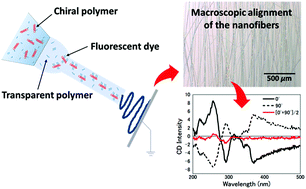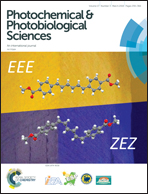Amplified polarization properties of electrospun nanofibers containing fluorescent dyes and helical polymer†
Abstract
Nanofibers with the cationic fluorescent molecules, 1-pyrenemethylamine hydrochloride (PyrMA) and α,β,γ,δ-tetrakis(1-methylpyridinium-4-yl)porphyrin p-toluenesulfonate (TMPyP), in the presence of complementary anionic chiral polysaccharide, hyaluronic acid (HA) and transparent polymer, polyethylene oxide (PEO) were successfully prepared using an electrospinning technique. The results showed that the fluorescence spectra of electrospun nanofibers (ENFs) of PEO-HA-PyrMA exhibit a higher amount of pyrene excimer emission when the [PyrMA]/[HA] ratio was increased from 0.5 to 1, while the concentration of TMPyP had no remarkable effect on the fluorescence of the PEO-HA-TMPyP ENFs. From circular dichroism (CD) characterization, the ENFs of both dyes exhibit stronger intensities in the apparent CD spectra upon increasing the dye ratio. Moreover, they also showed higher CD intensities when compared with those of solutions and thin films prepared using other methods. The apparent CD in this work was proved to mainly originate from linear dichroism (LD) and linear birefringence (LB) obtained by macroscopic alignment along the electrospinning process. These results suggest the advantages of molecular orientation via electrospinning, together with chirality induction by incorporation of a chiral HA polymer. The enhancement of these polarization properties provides great possibilities for improving fluorescent-chiral nanofibers for further optoelectronic applications.



 Please wait while we load your content...
Please wait while we load your content...